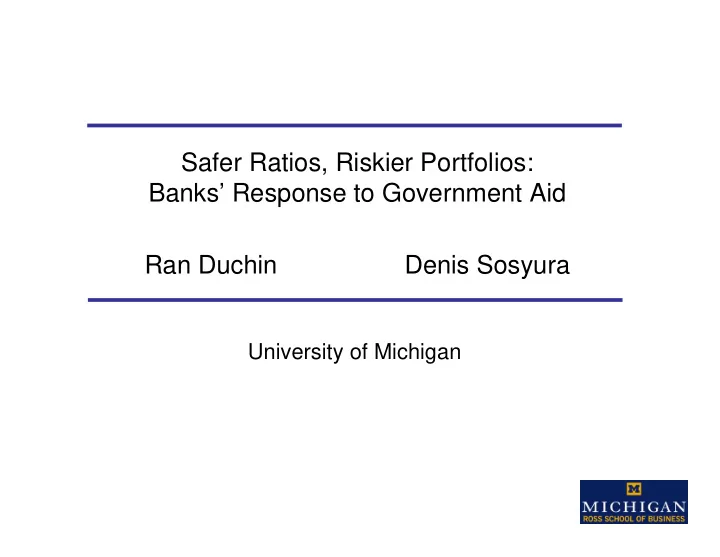

Safer Ratios, Riskier Portfolios: Banks’ Response to Government Aid Ran Duchin Denis Sosyura University of Michigan
Motivation Key economic features of the past decade: • Increased government regulation • Unprecedented wave of bailouts around the world Research question: what are the consequences? • credit origination • risk-taking What this amounts to is an unintended extension of the official safety net…The obvious danger is that risk-taking will be encouraged... - Paul Volcker 2
Hypotheses Did the bailout affect banks’ risk taking behavior? • Higher risk: Moral Hazard (Merton 1977; Flannery 1998) • Lower risk: Charter value (Keeley 1990; Cordella & Yeyati 2003) • Null: no effect • Government restrictions to curb risk taking: • Limits on incentive pay to prevent “excessive risk taking” • Limits on dividends & share repurchases to prevent asset substitution 3
Empirical Focus Capital Purchase Program, the largest TARP initiative • Stated goals: stimulate lending and increase financial stability $205 billion invested in over 700 firms, and banks are not required to report its use • “This is opportunity capital. They didn’t tell me I had to do anything particular with it.” - Chairman of PlainsCapital Bank • “Make more loans?” “We’re not going to change our business model or our credit policies to accommodate the needs of the public sector” - Chairman of Whitney National Bank 4
Identification Issues Selection criteria of bailed firms typically unknown • Unified decision framework + declared set of criteria (Camels) • Matched samples based on decision criteria Denials of government aid unobservable • Hand-collected data on applications for federal assistance Supply-side vs. demand side changes in credit and risk • Micro-level evidence at the level of loan applications Unobservable counterfactual • Collect data on banks that applied for TARP, were approved, but did not receive TARP capital 5
Data Hand-collected data on the status of TARP applications Application-level data on mortgages from HMDA • Borrower income, gender, and demographics • Property location by U.S. Census tract (area with about 4,000 residents) • Bank decision on the application Data on large corporate loans from DealScan • Originating bank, recipient firm, date of origination, and loan characteristics Housing market data: home vacancies, housing units, home price index, population, per capital income, and unemployment 6
Empirical Design Compare credit rationing of approved and denied TARP banks matched on regulators’ selection criteria, size, and crisis exposure Controlling for loan demand: Ann Retail loans Arbor • Applications submitted in the same housing market • Loan applications with similar observable characteristics Corporate loans: • Fraction of credit originated by approved vs. denied banks in a credit facility 7
Credit Rationing and Risk Dependent variable = indicator equal to 1 if a loan application is approved Loan-to-income ratio rank Overall Low High Sample 2 3 4 (safe) (risky) After CPP 0.030 0.045* 0.011 -0.024 0.006 -0.051 [1.059] [1.790] [0.353] [0.826] [0.207] [1.149] CPP Recipient -0.072*** 0.013 -0.046 -0.110*** -0.112** -0.065** [2.803] [0.449] [1.401] [3.979] [4.324] [2.164] After CPP x CPP Recipient 0.058 -0.123*** 0.019 0.076 0.109*** 0.175*** [1.623] [3.808] [0.436] [1.148] [2.938] [3.835] Bank level controls Yes Yes Yes Yes Yes Yes Demographic controls Yes Yes Yes Yes Yes Yes Housing market controls Yes Yes Yes Yes Yes Yes Tract fixed effects Yes Yes Yes Yes Yes Yes Borrower fixed effects Yes Yes Yes Yes Yes Yes 8 R-squared 0.226 0.142 0.209 0.256 0.270 0.249
Interpretation No significant effect of CPP on: • Total volume of credit origination • Distribution of demand for loans between approved and unapproved banks Significant effect on the risk of originated credit: • CPP banks shifted their credit origination toward riskier, higher yield mortgages Results are very similar for corporate loans Banks’ active decisions or government intervention? • Find a similar response across approved banks, whether or not they received capital unlikely driven by government intervention 9
Risk of Investment Portfolios TARP banks increase allocations to investment securities Most capital goes to equities, MBS, and corporate debt The combined weight of these assets increased by 10.0%, displacing Treasury bonds, short-term paper, and cash equivalents Using diff-in-diff estimation, the average interest yield on TARP recipients’ investments increased by 31.5% after the bailout 10
Bank Risk St. deviation St. deviation Capital asset Distance to Risk Measure Beta Volatility of ROA of earnings ratio default (z-score) After TARP -0.002 -0.001 0.022*** 0.100** 0.039*** -0.496*** [1.551] [1.203] [7.912] [1.999] [8.122] [6.180] TARP Recipient -0.006*** -0.006*** 0.000 -0.052* -0.008*** 0.830*** [4.537] [4.390] [0.119] [1.673] [5.767] [5.250] After TARP x 0.005*** 0.002*** 0.021*** 0.113** 0.020*** -0.128*** TARP recipient [4.593] [4.522] [10.320] [2.036] [4.289] [3.455] Bank level Yes Yes Yes Yes Yes Yes controls? Observations 7,178 7,178 7,185 5,632 5,632 7,122 R-squared 0.044 0.044 0.035 0.357 0.161 0.106 11
Economic Interpretation TARP recipients significantly reduced leverage: capital asset ratio increased from 9.9% before TARP to 10.9% after However, the reduction in leverage was more than offset by an increase in asset risk in loans and security investments Net effect: beta of TARP banks increased from 0.80 in 2008 to 1.01 in 2009 Strategy consistent with investing in higher-yield assets, while improving capital ratios monitored by the regulators 12
Should We Care? April 18, 2011: S&P lowers the U.S. government debt outlook to negative • The risks from the U.S. financial sector are higher than before 2008 • Higher probability and cost to U.S. government of another round of extraordinary assistance Aug. 5, 2011: S&P downgrades U.S long-term debt for the first time since beginning ratings in 1860 13
Conclusion Liquidity shocks have an asymmetric effect on lending Banks’ strategic response to capital requirements erodes the efficacy of this mechanism in risk regulation Moral hazard likely outweighs government monitoring and institutional restrictions 14
Recommend
More recommend